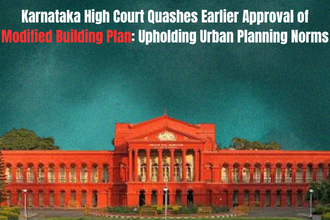In a significant ruling impacting urban development and building regulations in Karnataka, the Karnataka High Court has quashed the approval granted by the Bruhat Bengaluru Mahanagara Palike (BBMP) for a modified building plan submitted by Sangam Enterprises. The decision emphasizes that building approvals must strictly adhere to statutory regulations and the prevailing urban planning norms at the time of sanction. This landmark ruling highlights the judiciary’s role in ensuring that urban development projects are legally compliant, sustainable, and aligned with safety and planning standards.
Background of the Case
Sangam Enterprises had sought to utilize a Transferable Development Rights (TDR) certificate dated April 18, 2015, to increase the height and floor area of its building located in Bengaluru’s Majestic area. The property, measuring 5,630 square meters, initially had approval for construction up to 15 meters in height. With the TDR certificate and referencing a BBMP circular from 2009, the petitioner requested approval for a revised plan that proposed to increase the height to 29.6 meters and relax setback norms by 50%.
The firm had also obtained a No Objection Certificate (NOC) from the Karnataka Fire and Emergency Services Department in 2017, an essential clearance for buildings exceeding certain heights. Despite this, BBMP withheld approval for the modified building plan, citing regulatory non-compliance.
Sangam Enterprises filed a writ petition challenging BBMP’s refusal. A single-judge bench of the Karnataka High Court in May 2024 directed BBMP to approve the modified plan. Unsatisfied with this, BBMP appealed before the division bench, asserting that the approval should comply with the rules effective at the time of sanction and not merely based on prior circulars or TDR certificates.
Court’s Observations
The division bench, led by Chief Justice Vibhu Bhat, carefully examined the timeline and regulatory framework governing building approvals. Key observations included:
- Applicability of Statutory Regulations: The court emphasized that building plan approvals must comply with the statutory framework in force at the time the approval is granted. It clarified that the rules in effect when the application is made do not automatically bind the authorities if subsequent amendments have been introduced.
- Transferable Development Rights (TDR): While TDR certificates allow developers to increase floor space, their utilization is strictly regulated. The bench noted that TDR usage must conform to the prevailing rules at the time of sanction, not the date of purchase or issuance.
- Fire Safety and Other Clearances: Though the petitioner obtained a NOC from the Fire and Emergency Services Department, the High Court emphasized that such clearance alone does not override the requirements set by the BBMP under the Karnataka Town and Country Planning Act.
- Previous Orders and Compliance: The court observed that the single-judge order directing BBMP to approve the plan had not adequately considered amendments in the planning rules post-2017. The bench held that any deviation from the statutory norms could compromise urban safety, planning integrity, and adherence to lawful procedures.
Legal Principles Established
This ruling establishes several important legal principles for urban development and planning in Karnataka:
1. Compliance with Current Regulations
The High Court reaffirmed that building approvals must adhere to the regulations in force at the time of approval. Developers and municipal authorities cannot rely solely on historical circulars, earlier permissions, or outdated TDR certificates to bypass contemporary planning norms.
2. Transferable Development Rights (TDR) Utilization
The judgment provides clarity on TDR usage. While TDR allows additional floor space or building height, its application must align with current statutory guidelines. Arbitrary or outdated interpretations cannot be used to circumvent rules governing floor area ratio, setbacks, or maximum building height.
3. Judicial Oversight in Urban Planning
The case highlights the judiciary’s critical role in ensuring transparency and legality in urban development. Courts serve as an oversight mechanism to prevent municipal authorities from either unlawfully granting approvals or withholding them, thus maintaining checks and balances in governance.
4. Impact of Rule Amendments
The ruling underscores that amendments to urban planning regulations are binding on all pending and future applications unless explicitly exempted. Developers must ensure that applications reflect compliance with the latest amendments to avoid invalidation.
Broader Implications for Developers and Urban Governance
This decision has significant implications for developers, municipal authorities, and urban planners:
- Enhanced Scrutiny of Building Plans: Municipal authorities may exercise greater diligence in reviewing building plans, ensuring that all approvals strictly comply with statutory and regulatory frameworks.
- Legal Certainty for Developers: Developers are reminded that obtaining a TDR or earlier NOCs does not guarantee future approvals. Compliance with the current planning framework is non-negotiable.
- Protection of Public Interest: The judgment safeguards public interest by preventing constructions that violate safety norms, planning restrictions, or setback regulations, ensuring sustainable urban growth.
- Judicial Precedent: The ruling sets a benchmark for future cases, establishing that courts will closely scrutinize approvals and prioritize adherence to statutory norms over procedural convenience or outdated permissions.
Related Legal Context
The Karnataka High Court has historically played a pivotal role in regulating urban development and protecting legal compliance. Notable cases include:
- Landowners Cannot Retain Portions Post-Sale Deed: The Court held that landowners cannot retain parts of land after executing sale deeds for apartment projects, ensuring clear title and lawful ownership.
- BBMP Fees and Penalties Struck Down: The Court has previously invalidated amendments enabling BBMP to collect certain fees and penalties for building plan sanctions, highlighting the need for statutory adherence and lawful authority.
- No Objection Certificate Clarifications: High Court rulings have clarified that NOCs for construction, including fire safety, must complement municipal approvals and cannot override statutory planning rules.
Conclusion
The Karnataka High Court’s decision to quash the approval of Sangam Enterprises’ modified building plan reinforces the primacy of statutory compliance in urban development. The ruling ensures that municipal authorities, developers, and urban planners adhere to the prevailing legal framework, balancing development goals with public safety and urban sustainability.
As Bengaluru and other urban centers in Karnataka continue to grow, this judgment serves as a critical precedent, reminding stakeholders that:
- Compliance with current building regulations is mandatory.
- TDRs must be used within the framework of statutory provisions at the time of approval.
- Judicial oversight plays a crucial role in ensuring transparency, legality, and fairness in urban governance.
For developers, municipal bodies, and legal practitioners, the ruling is a clarion call to ensure that urban development projects are legally sound, environmentally sustainable, and socially responsible. It reinforces the principle that urban growth must be lawful, planned, and accountable, safeguarding both citizens and the integrity of urban planning systems.
Also Read
Supreme Court Praises Enforcement Directorate for Restitution of Flats to 213 Delayed Homebuyers



